If you’re shopping for a reliable battery charger or maintainer, comparing the Noco Genius 5 and Noco Genius 10 is a smart choice.
I’ve used both models extensively on cars, motorcycles, and deep-cycle batteries, and this review will walk you through real-world experiences, key features, pros and cons, and which model fits your needs best.
By the end, you’ll know whether the 5 or 10 amp charger is the right investment for your setup.
Comparison Table: Genius 5 Vs. Genius 10
| Feature | Noco Genius 5 | Noco Genius 10 |
| Output Current | 5 amps | 10 amps |
| Best For | Smaller batteries, motorcycles, small cars | Larger vehicle batteries, boats, RVs |
| Weight | Compact and lightweight | Slightly larger but still portable |
| Charging Speed | Moderate | Faster charging |
| Maintenance Mode | Yes | Yes |
| Multi-Battery Compatibility | 6–12 V, up to 120 Ah | 6–12 V, up to 230 Ah |
| Safety Features | Spark proof, reverse polarity protection | Same |
| Price Range | Lower | Higher |
| Ideal User | Solo vehicle owner, light-duty | Enthusiast, fleet, heavy use |
My Experience Using Genius 5 and Genius 10

When I bought my first motorcycle, I got the Genius 5 to keep the battery healthy during winter storage.
It was light, easy to hook up, and I appreciated how it ran silently in the garage. Over a few months, the battery stayed strong without me having to worry.
Later, I upgraded to an SUV with a dead battery after a long trip. That’s when I got the Genius 10.
The extra output made a night-and-day difference. It charged more quickly and handled that larger battery effortlessly.
I could also maintain two batteries simultaneously using split leads—handy for my RV and car without buying a second unit.
Using both, I began to notice subtle differences. The Genius 10 stayed cooler during extended charging sessions.
The Genius 5 took longer and sometimes seemed to struggle with vehicle loads over 100 Ah. In contrast, the Genius 10 powered through heavy drips on my RV system and picked up 30 Ah in less than two hours.
I also left both units connected after successful charges. Though rated for maintenance mode, I saw the Genius 5 occasionally drop into idle and cycle.
The Genius 10, however, remained rock solid, replenishing small losses more consistently.
In short: the Genius 5 is great for occasional use and smaller batteries; the Genius 10 is built for routine use, larger systems, and tougher conditions.
Choosing the Right Charger Based on Battery Type

One of the key things I realized using both the Genius 5 and Genius 10 is how much your battery type affects which charger you should choose.
It’s not just about amps—it’s about matching the charger’s capability with the demands of your vehicle or equipment.
If you’re mostly working with motorcycles, lawn mowers, jet skis, or small compact cars, the Genius 5 is honestly more than enough.
These batteries are generally under 80Ah, and the 5-amp output can bring them up to full charge within a few hours.
I’ve left it on my motorcycle battery for days at a time without issue, and it maintained voltage perfectly through cold snaps.
But when you’re dealing with larger vehicles—like pickup trucks, SUVs, RVs, or even boats—you start to see the Genius 5 taking longer than expected.
That’s where the Genius 10 really shines. With higher capacity batteries (100Ah+), you need more power to get a quick and full charge.
I noticed the Genius 10 could top off my SUV battery in half the time it took the Genius 5.
For AGM, lithium, and deep-cycle marine batteries, the Genius 10 also performs better.
It has dedicated modes for different chemistries, and the larger amperage provides more consistent results.
While both models are versatile, the Genius 10 gives you more headroom if you’re unsure what batteries you’ll be dealing with down the road.
So think about your battery type and future use before buying. That one choice could save you hours—or leave you waiting.
Maintenance Tips for Genius Chargers

- Inspect connections regularly: Make sure the clamps and ring terminals are clean, tight, and corrosion-free before each use.
- Store in a dry, cool place: When off-season, keep the unit plugged into battery and tucked away to avoid dust and moisture.
- Use manufacturer cables: Extension cords or generic clamps may reduce efficiency or cause sparks.
- Don’t charge below 6 V: Both models need at least 6 V to begin charging—otherwise they provide no current.
- Allow cool-down after heavy use: For Genius 10 sessions exceeding two hours, give it a 15-minute rest to prevent overheating.
- Check charge status monthly in maintenance mode: Even though it maintains automatically, monitor voltage and final float charge once a month.
- Avoid hotspots: Keep the unit out of direct sunlight or near heat sources during charging.
- Replace clamps if needed: If clamp springs weaken or jaws misalign, replace them before losing proper contact.
- Use on a heavy-duty outlet: Don’t run off extension cords or low-gauge wiring for extended charging—you may trigger internal overheat protection.
- Keep firmware up-to-date if applicable: Check for updates occasionally; newer units sometimes include enhanced charging profiles via firmware.
Pros and Cons of Genius 5 Vs. Genius 10

Pros:
- Step 1: Versatility: Both models support 6 V and 12 V batteries, making them useful across motorcycles, cars, boats, and RVs.
- Step 2: Smart Charging: They use multi-stage charging that adjusts automatically, preventing overcharge and sulfation.
- Step 3: Safety Features: With reverse polarity protection and spark-proof connectors, even a newbie can hook them up without worry.
- Step 4: Maintenance Mode: Leave either connected indefinitely for battery upkeep without damaging cells.
- Step 5: Cold and Hot Weather Performance: Both models deliver up to –4 °F and perform reliably in harsh conditions.
- Step 6: Durable Build: They’re compact, weather-resistant, and have tough housing that handles garage or roadside take-downs.
Cons:
- Step 1: Slower Charging with Genius 5: It works for small batteries, but for larger batteries over 100 Ah you’ll wait much longer than with the Genius 10.
- Step 2: Heavier Weight on Genius 10: At around three pounds, it’s still portable but noticeably heavier than the Genius 5.
- Step 3: Price Gap: The 10-amp model costs significantly more, which might not be worth it for only occasional use.
- Step 4: Limited Multi-Battery Output: Neither supports simultaneous charging of mixed voltage batteries or advanced multi-bank systems.
- Step 5: No USB or Smart App: You’ll lose out on mobile monitoring or app control that some competitors offer.
- Step 6: Loud Internal Fan on Genius 10 in High Demand: It stays cool, but the fan spins up during longer sessions—it’s noticeable in quiet environments.
- Step 7: Not for High-C Ranking Batteries: Very large deep-cycle batteries may require more powerful chargers for full recovery.
Also Read: My Thoughts On NOCO Battery Charger
Noco Genius 5 Vs. Other Brands
- Genius 5 Vs. NOCO Genius 1
Genius 1 is compact and designed for really small batteries, like lawn equipment. While useful, it lacks multi-stage smart charging. The Genius 5 adds that feature with more power and endurance. If you’re charging anything bigger than a small engine battery, the extra power and safety controls in the Genius 5 are very noticeable.
- Genius 5 Vs. Schumacher SC1280
Schumacher SC1280 is cheaper and charges quickly but lacks the maintenance float mode and fail-safe controls of Noco. The SC1280 might top off a battery faster, but it won’t protect it over time. For ongoing battery life, the Genius 5 offers better long-term value.
- Genius 5 Vs. CTEK MXS 5.0
CTEK has a polished design and clear LED interface. Its MXS 5.0 is excellent. However, it doesn’t offer as much amperage range or rugged portability compared to the Genius 5. For light-duty, CTEK is fine—but for charging multiple battery types and sizes, the Genius 5 gives you more flexibility.
- Genius 5 Vs. Battery Tender Plus 4 Amp
Battery Tender is very user-friendly, but it’s slower and relies on older technology. Noco’s Genius 5 charges faster, handles more battery types, and has superior protection against reverse polarity or spark hazards.
- Genius 5 Vs. OTC 1200
OTC 1200 is a basic charger with no float mode. It can charge but not maintain batteries safely. If you leave it connected too long, you risk overcharging. Noco Genius 5, in contrast, manages charge intelligently and automatically adjusts current—all without supervision.
Also Read: My Thoughts On Battery Tender
Frequently Asked Questions (FAQs)
If you have smaller batteries or want portability—a 5 amp may be enough. For faster charging and larger systems, a 10 amp charger delivers better performance.
Yes, if you frequently work with medium to large batteries. It charges faster, maintains more reliably, and handles dual-battery setups better than the 5 amp.
They differ in maximum amperage (1, 5, 10, 16, or 20 amps), vehicle support, and thermal control. They all use smart multistage charging and offer similar safety features.
Yes. It enters maintenance mode once the battery is fully charged and can stay connected indefinitely without damaging the battery.
Final Thoughts
If you want a dependable, smart battery charger that you can use across vehicles—from motorcycle to RV—the Noco Genius 10 is the more powerful, faster option.
But if you just need something lightweight, cost-effective, and fine for smaller batteries, the Genius 5 still delivers great value and reliability.
Whether you choose the 5 or the 10 amp model, you’ll be getting advanced charging logic, top-tier safety features, and a tool that will last years if maintained well—just pick based on your typical battery size and how often you charge.

